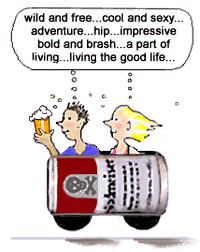

Our
mission is to reduce the number of injuries and deaths due to
injuries,
through prevention, improved trauma care, and improved rehabilitation.
"Alcohol is the drug most often abused by teens, and alcohol use plays a substantial role in all three leading causes of death among youth. It is important for all states to implement effective policies to protect our kids."
--David Jernigan,
.
CAMY's Research Director
Alcohol Marketing--Driving Youth to Drink

Alcohol is the leading drug of abuse among young people in the United States.
While approximately 41% of adult drinkers report heavy drinking on one or
more occasions in the last month, 51% of 12-to-14 year-old drinkers, 65% of
15-to 17-year-old drinkers and 71% of 18- to 20-year-old drinkers report
heavy drinking in the past month.
Underage drinkers are estimated to consume 12% of the total 4.21 billion drinks consumed every month in the U.S.
Consumers spent $116.2 billion dollars on alcohol in the U.S. in 1999. Of that,
at least $10 billion was attributed to
underage drinking.
(Office of Juvenile Justice and Delinquency Prevention. Drink
in America: Myths, Realities, and Prevention Policy. August, 2002, and Foster et al. Alcohol Consumption and Expenditures for Underage Drinking and Adult Excessive Drinking.
JAMA Feb 26, 2003 Vol 289, No. 8)
Young underage drinkers account for substantial numbers of treatment admissions for primary alcohol abuse.
Young people under age 21 accounted for 14% of admissions for alcohol with a secondary drug problem (approx 45,000 in 1999) and 6% of alcohol-only admissions (approx 26,000 in 1999).
In a series of reports, The Center on Alcohol Marketing and Youth
(CAMY) (www.camy.org) has examined alcohol ads seen by youth in print, on television and radio. Throughout these various reports, CAMY discovered that in general,
young, underage drinkers are consistently exposed to the alcohol industry's
advertising, despite the industry's claims
that this is not the case.
Some of CAMY's findings include:
Marketers of beer and distilled spirits brands delivered more advertising to young people than to adults in magazines in 2001. Youth saw 45% more beer ads and 27% more distilled spirits ads.
Marketers of low-alcohol content refreshers such as the "malternatives" like Smirnoff Ice, delivered 60% more advertising to youth than adults.
Ten magazines with audiences comprised of 25% or more underage young people accounted for nearly one-third of all alcohol advertising expenditures in measured magazines. More than half of the money spent on alcohol magazine advertising was spent on ads appearing in 24 magazines with youth audiences that exceeded 15.8%.
Twenty-five brands placed all of their advertising in youth-oriented
magazines. (Overexposed: Youth a Target of Alcohol Advertising in Magazines CAMY 2002)
Youth heard more radio ads for beer, "malternatives," and distilled spirits. Underage youth, ages 12-20, heard 8% more beer and ale advertising and 12% more malternative advertising than adults 21 and older. The exposure was even greater for the distilled spirits category, where youth heard 14% more advertising.
Alcohol ads were placed on stations with "youth" formats. Seventy-three percent of the alcohol radio advertising in terms of gross ratings points was on four formats
— Rhythmic Contemporary Hit, Pop Contemporary Hit, Urban Contemporary and Alternative
— that routinely have a disproportionately large listening audience of 12-to-20-year-olds.
Youth in African-American and Latino communities were overexposed to radio alcohol advertising. These findings were also seen in the African-American and Latino radio audiences. For instance, Latino youth heard 34% more
beer and ale advertising on radio than Hispanic adults, and as much beer and ale advertising on radio was delivered to African-American youth as to African-American adults.
(Radio Daze)
The alcohol industry's voluntary guidelines for ad placements on television are so lax that they allow the substantial exposure of youth to alcoholic beverage advertising, including advertising on programs with disproportionate numbers of young people in the viewing audience.
Could you believe the following quote, given the above
facts? "...no one can match the alcohol industry's long-term commitment to public-service advertising that discourages
underage drinking, along with warning adults to drink responsibly." --Jeff
Perlman, Executive Vice President - Government
Affairs and General Counsel, American Advertising Federation, Dec. 19, 2002.
Clearly, young people are being exposed to the alcohol industry's advertising and many are experiencing alcohol-related
problems. Prevention advocates and policy makers need to work toward policy solutions that will put the
brakes on the industry's egregious predatory advertising practices which sacrifice the lives and futures of
young people to corporate greed.
What States Can Do:
- Establish state alcohol fees and taxes that fund counter-advertising campaigns.
- Conduct ongoing research on alcohol marketing practices and their impact on youth drinking practices and problems, including:
- Amount of alcohol industry expenditures on differing forms of marketing;
- Extent of youth overexposure to alcohol advertising and promotion, by brand;
- Youth brand preferences and the association of these preferences to youth exposure to brand advertising.
- Issue annual reports summarizing the findings of this research and widely disseminate the reports to key constituencies and the public.
- Reduce youth exposure to alcohol advertising:
- Restrict alcohol industry promotions and sponsorships at community events;
- Restrict outdoor advertising in locations where children are likely to be present;
- Prohibit alcohol advertising and sponnsorships on college campuses;
- Prohibit alcohol advertising on in-state radio and television programming with high proportions of youth audiences;
- Promote efforts in local communities to adopt similar measures adapted to local circumstances.
To find out which states have already implemented policies to address these issues, see States Critical in Protecting Youth from Alcohol Marketing
 |
 |
|---|